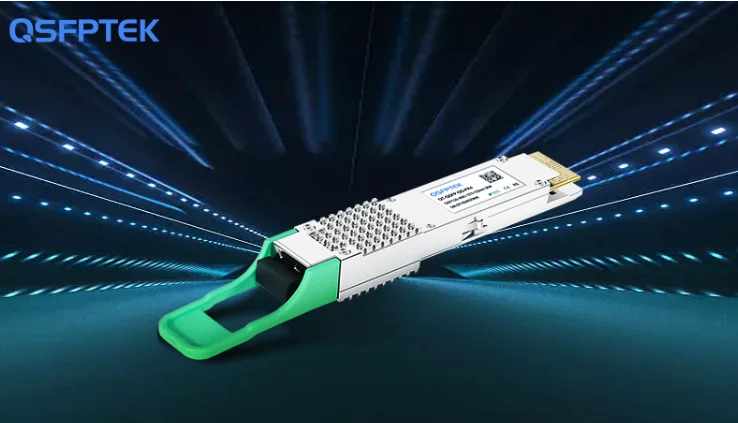The ever-growing demand for bandwidth in data centers and telecommunications networks requires high-performance and efficient transmission solutions. 400G optical transceivers have established themselves as the new standard in this segment. Within this segment, the 400G FR4 module represents a particularly versatile and cost-effective solution for transmission over single-mode fiber (SMF). This article highlights the technology, the various module form factors, and the key advantages of 400G FR4.
What Does 400G FR4 Mean?
FR4 is an IEEE standard designation: FR stands for “2km Reach” over single-mode fiber.
4 represents the four optical channels (wavelengths) used for transmission.
Unlike other standards such as DR4, which require four separate fiber pairs, FR4 combines all four optical channels onto a single fiber in each direction using wavelength division multiplexing (WDM). An FR4 transceiver therefore requires only one duplex LC fiber optic cable (two fibers) for full 400G operation. Each of the four channels transmits 100 Gb/s, resulting in a total data rate of 400 Gb/s.
OSFP-400G-FR4 vs QDD-400G-FR4 vs OSFP-400G-2FR4
The 400G-FR4 technology is available in several common package formats to meet different switch port requirements:
OSFP-400G-FR4: This OSFP (Octal Small Form-factor Pluggable) module is designed for 400GBASE-FR4 applications and enables distances of up to 2 km over a duplex LC-SMF cable.
QDD-400G-FR4: The counterpart in the QSFP-DD form factor (Quad Small Form-factor Pluggable Double Density) offers the same FR4 functionality – 400G over 2 km on a duplex SMF with an LC connector – and is designed for switches with QSFP-DD ports.
OSFP-400G-2FR4: The flexible breakout solution
This module is a special variant that offers maximum flexibility. Technically, it consists of two independent 200G-FR4 links in a single housing.
“2FR4” stands for 2 x 200G-FR4.
Each of the two 200G links uses its own fiber pair (a total of four fibers) and transmits over four optical channels at 50 Gb/s each.
The key advantage: The module can be operated in “breakout” mode. A 400G port in the switch can be configured to provide two independent 200G connections. This allows connection to two separate 200G FR4 transceivers or, with appropriate configuration, even two 100G transceivers such as the QSFP-100G CWDM4. A dual CS connector is used to connect the two fiber pairs.

Applications and Benefits
400G FR4 transceivers are the ideal choice for point-to-point connections over distances of up to 2 km. Typical applications include connections within data centers between racks or buildings on a campus.
Perhaps the most significant advantage is seamless backward compatibility. 400G QSFP-DD or OSFP FR4 uses the same duplex fiber infrastructure as established 100G optical standards (e.g., 100G CWDM4, 100G LR4, 100G DR/FR/LR). This means that upgrading from 100G to 400G can be achieved without any changes to existing fiber cabling. This saves significant costs and minimizes operational disruption.

Interoperability and Breakout Scenarios
Interoperability with LR4: 400G-FR4 and 400G-LR4 transceivers are interoperable up to a range of 2 km (limited by the FR4 specification). Note that attenuation may be required, as the LR4 transmitter can have a higher output power.
Breakout to Slower Speeds: As explained with the OSFP-400G-2FR4, some modules support breakout capabilities. For example, an OSFP-400G-2FR4 module can be used to split a 400G port into two 200G ports. By configuring the switch port for slower electrical signaling (e.g., 8x 25 Gb/s NRZ), it is even possible to connect two separate 100G QSFP transceivers, protecting the investment in existing hardware and facilitating migration.
Conclusion
The 400G FR4 optical transceiver is a mature, reliable, and cost-effective key technology for expanding network core infrastructures. Its ability to deliver high bandwidth over long distances while building on existing fiber infrastructure makes it the first choice for operators seeking to upgrade their networks to 400G in a future-proof, flexible, and cost-effective manner. Availability in various form factors and with flexible operating modes such as 2FR4 underscores its versatility for the requirements of modern data centers.







